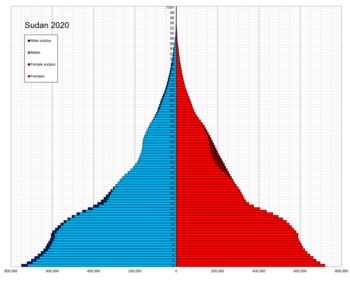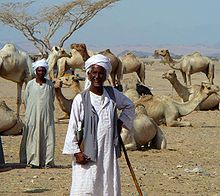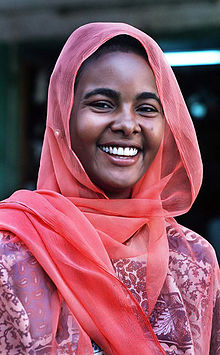
A | B | C | D | E | F | G | H | CH | I | J | K | L | M | N | O | P | Q | R | S | T | U | V | W | X | Y | Z | 0 | 1 | 2 | 3 | 4 | 5 | 6 | 7 | 8 | 9
| Demographics of Sudan | |
|---|---|
 Population pyramid of Sudan in 2020 | |
| Population | 50,467,278 (2024 est.)[1] |
| Growth rate | 2.55% (2022 est.) |
| Birth rate | 33.47 births/1,000 population (2022 est.) |
| Death rate | 6.3 deaths/1,000 population (2022 est.) |
| Life expectancy | 67.12 years |
| Fertility rate | 4.6 children born/woman (2022 est.) |
| Infant mortality rate | 42.27 deaths/1,000 live births |
| Net migration rate | -1.67 migrant(s)/1,000 population (2022 est.) |
| Age structure | |
| 0–14 years | 42.01% |
| 65 and over | 3.03% |
| Nationality | |
| Nationality | Sudanese |
| Language | |
| Official | Arabic, English |
The demographics of Sudan include the Sudanese people (Arabic: سودانيون) and their characteristics, Sudan, including population density, ethnicity, education level, health, economic status, religious affiliations, and other aspects of the population.

In Sudan's 1993 census, the population was calculated at 30 million. No comprehensive census has been carried out since that time due to the Second Sudanese Civil War. Estimates of Sudan, including the population of South Sudan, ranged from 37 million (United Nations) to 45 million (CIA). Since the secession of South Sudan in July 2011, the current population of Sudan is estimated to be about 46 million.[2][3] The population of metropolitan Khartoum (including Khartoum, Omdurman, and Khartoum North) is growing rapidly and ranges from six to seven million, including around two million displaced persons from the southern war zone, as well as western and eastern drought-affected areas.
Population overview
The majority of the population in Sudan are the indigenous Nubian inhabitants of the Nile Valley. The majority of ethnic groups of Sudan fall under Arabs, and the minority being Other African ethnic groups such as the Beja,[4] Fur, Nuba, and Fallata.[5] When counted as one people Sudanese Arabs are by far the largest ethnic group in Sudan, however African ethnic groups are a large minority if counted as one group. They are almost entirely Muslim; while the majority speak Sudanese Arabic; some other Arab tribes speak different Arabic dialects like Awadia and Fadnia and Bani Arak tribes who speak Najdi Arabic; Bani Hassan, Al-Ashraf, Kinanah and Rashaida who speak Hejazi Arabic. In addition, Arab tribes like the Baggara and other Darfurians, both who speak Chadian Arabic.[6] Sudanese Arabs of northern and eastern parts descend primarily from migrants from the Arabian Peninsula. Additionally, a few pre-Islamic Arabian tribes existed in Sudan from earlier migrations into the region from Western Arabia, although most Arabs in Sudan are dated from migrations after the 12th century.[7] The vast majority of Arab tribes in Sudan migrated into the Sudan in the 12th century.[8]
Population statistics







Achieving good counts of the population is difficult in Sudan, because conducting a census has been difficult due to various conflicts and wars in the southern, eastern and western regions of Sudan over the past few decades. The government of South Sudan (led by the former SPLM resistance movement) has in the past accused Sudan of deliberately manipulating the census in oil-rich regions such as the Abyei district, on the border between Sudan and South Sudan. The population count is a determining factor for the share of wealth and power each part of Sudan receives after the secession of South Sudan (See: Naivasha Agreement). Another complication is the Southern Sudanese refugees present in the north, whose citizenship in Sudan after the secession of South Sudan is now in question.[9] 250,000 refugees from Syria live in Sudan.[10]
Population Estimates by Sex and Age Group (01.VII.2016) (Unrevised data.):[11]
| Age Group | Male | Female | Total | % |
|---|---|---|---|---|
| Total | 20 105 842 | 19 541 779 | 39 647 621 | 100 |
| 0–4 | 3 506 328 | 3 377 853 | 6 884 181 | 17.36 |
| 5–9 | 2 801 266 | 2 677 988 | 5 479 254 | 13.82 |
| 10–14 | 2 325 624 | 2 196 472 | 4 522 096 | 11.41 |
| 15–19 | 2 073 006 | 1 952 605 | 4 025 611 | 10.15 |
| 20–24 | 1 816 041 | 1 721 450 | 3 537 491 | 8.92 |
| 25–29 | 1 547 613 | 1 519 393 | 3 067 006 | 7.74 |
| 30–34 | 1 295 965 | 1 329 629 | 2 625 594 | 6.62 |
| 35–39 | 1 085 101 | 1 136 535 | 2 221 636 | 5.60 |
| 40–44 | 891 195 | 949 131 | 1 840 327 | 4.64 |
| 45–49 | 732 711 | 762 251 | 1 494 962 | 3.77 |
| 50–54 | 589 400 | 586 304 | 1 175 703 | 2.97 |
| 55–59 | 458 118 | 441 240 | 899 359 | 2.27 |
| 60–64 | 340 396 | 314 518 | 654 915 | 1.65 |
| 65-69 | 248 570 | 225 431 | 474 001 | 1.20 |
| 70-74 | 170 069 | 152 437 | 322 506 | 0.81 |
| 75-79 | 109 224 | 97 712 | 206 936 | 0.52 |
| 80+ | 115 214 | 100 828 | 216 042 | 0.54 |
| Age group | Male | Female | Total | Percent |
| 0–14 | 8 633 218 | 8 252 313 | 16 885 531 | 42.59 |
| 15–64 | 10 829 547 | 10 713 058 | 21 542 605 | 54.34 |
| 65+ | 643 077 | 576 408 | 1 219 485 | 3.08 |
Population Estimates by Sex and Age Group (01.VII.2020) (Data refer to national projections.):[12]
| Age Group | Male | Female | Total | % |
|---|---|---|---|---|
| Total | 20 857 303 | 20 281 599 | 41 138 904 | 100 |
| 0–4 | 2 873 465 | 2 773 594 | 5 647 059 | 13.73 |
| 5–9 | 2 571 562 | 2 483 977 | 5 055 532 | 12.29 |
| 10–14 | 2 304 529 | 2 216 524 | 4 521 059 | 10.99 |
| 15–19 | 2 280 148 | 2 152 491 | 4 432 638 | 10.77 |
| 20–24 | 2 158 344 | 1 943 776 | 4 102 116 | 9.97 |
| 25–29 | 1 821 785 | 1 665 559 | 3 487 349 | 8.48 |
| 30–34 | 1 442 332 | 1 474 329 | 2 916 654 | 7.09 |
| 35–39 | 1 179 849 | 1 330 120 | 2 509 965 | 6.10 |
| 40–44 | 1 000 575 | 1 110 734 | 2 111 309 | 5.13 |
| 45–49 | 855 408 | 909 671 | 1 765 081 | 4.29 |
| 50–54 | 717 995 | 717 820 | 1 435 807 | 3.49 |
| 55–59 | 545 001 | 511 980 | 1 056 992 | 2.57 |
| 60–64 | 404 866 | 374 598 | 779 458 | 1.89 |
| 65-69 | 275 266 | 247 207 | 522 480 | 1.27 |
| 70-74 | 199 364 | 173 388 | 372 747 | 0.91 |
| 75-79 | 125 079 | 106 375 | 231 456 | 0.56 |
| 80+ | 103 574 | 92 332 | 195 909 | 0.48 |
| Age group | Male | Female | Total | Percent |
| 0–14 | 7 749 556 | 7 474 095 | 15 223 651 | 37.01 |
| 15–64 | 12 404 464 | 12 188 202 | 24 592 666 | 59.78 |
| 65+ | 703 283 | 619 302 | 1 322 585 | 3.21 |
Vital statistics
The vital statistics below do not include South Sudan.
| Year[13] | Mid-year population (thousands) | Live births (thousands) | Deaths (thousands) | Natural change (thousands) | CBR* | CDR* | NC* | IMR* | TFR* | Life expectancy (years) |
|---|---|---|---|---|---|---|---|---|---|---|
| 1950 | 6 191 | 296 | 114 | 182 | 47.8 | 18.4 | 29.4 | 123.7 | 6.69 | 46.77 |
| 1951 | 6 380 | 305 | 116 | 189 | 47.8 | 18.2 | 29.6 | 122.5 | 6.68 | 47.05 |
